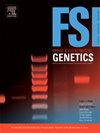Inter-laboratory evaluation of the VISAGE enhanced tool and models for age estimation from blood and buccal cells
IF 3.1
2区 医学
Q2 GENETICS & HEREDITY
引用次数: 0
Abstract
Over the past decade, numerous assays for forensic age estimation based on the analysis of DNA methylation markers have been developed, demonstrating significant potential for use in criminal investigations. Despite these advancements, only few comprehensive evaluation studies were published. In this study, we present findings of an extensive inter-laboratory evaluation of the VISAGE Enhanced Tool and its associated statistical models for epigenetic age estimation in blood and buccal swabs. Six laboratories conducted reproducibility, concordance, and sensitivity assessments using DNA methylation controls alongside blood and saliva samples to evaluate the tool's technical performance. Results demonstrated consistent and reliable DNA methylation quantification across all participating laboratories, with the tool maintaining sensitivity even with a DNA input of 5 ng for bisulfite conversion. To evaluate the age estimation models, 160 blood and 100 buccal swab samples were analysed in three laboratories. The models achieved mean absolute errors (MAEs) of 3.95 years for blood and 4.41 years buccal swabs, which represents an increase of ∼0.7 years for both tissues to the results from the original VISAGE testing set. When comparing results of each laboratory with the original VISAGE testing set, significant differences were found only for age estimation results from blood of one laboratory with an underestimation of chronological age observed within the entire range tested at that laboratory. When excluding this laboratory, the MAE decreased to 3.1 years (N = 89). No significant differences among laboratories were found for buccal swabs. Overall, this study confirms that the VISAGE Enhanced Tool performs robust DNA methylation quantification and reliable age prediction, however protocol and model validation within each laboratory is required upon implementation.
实验室间评估的VISAGE增强工具和模型的年龄估计从血液和颊细胞
在过去的十年中,已经开发了许多基于DNA甲基化标记分析的法医年龄估计分析,显示出在刑事调查中使用的巨大潜力。尽管取得了这些进展,但发表的综合评价研究很少。在这项研究中,我们展示了对VISAGE增强工具及其相关统计模型在血液和口腔拭子中进行表观遗传年龄估计的广泛实验室间评估的结果。六个实验室使用DNA甲基化对照以及血液和唾液样本进行了可重复性、一致性和敏感性评估,以评估该工具的技术性能。结果表明,在所有参与的实验室中,DNA甲基化定量一致且可靠,即使在亚硫酸氢盐转化的DNA输入为5 ng时,该工具仍保持灵敏度。为了评估年龄估计模型,在三个实验室分析了160份血液和100份口腔拭子样本。该模型的血液和口腔拭子的平均绝对误差(MAEs)分别为3.95年和4.41年,与原始VISAGE测试集的结果相比,这两种组织的平均绝对误差增加了0.7年。当将每个实验室的结果与原始VISAGE测试集进行比较时,仅在一个实验室的血液年龄估计结果中发现显着差异,在该实验室测试的整个范围内观察到对实足年龄的低估。排除该实验室后,MAE降至3.1年(N = 89)。各实验室间口腔拭子检测结果无显著差异。总的来说,本研究证实了VISAGE增强工具可以进行强大的DNA甲基化量化和可靠的年龄预测,但是在实施时需要在每个实验室进行协议和模型验证。
本文章由计算机程序翻译,如有差异,请以英文原文为准。
求助全文
约1分钟内获得全文
求助全文
来源期刊
CiteScore
7.50
自引率
32.30%
发文量
132
审稿时长
11.3 weeks
期刊介绍:
Forensic Science International: Genetics is the premier journal in the field of Forensic Genetics. This branch of Forensic Science can be defined as the application of genetics to human and non-human material (in the sense of a science with the purpose of studying inherited characteristics for the analysis of inter- and intra-specific variations in populations) for the resolution of legal conflicts.
The scope of the journal includes:
Forensic applications of human polymorphism.
Testing of paternity and other family relationships, immigration cases, typing of biological stains and tissues from criminal casework, identification of human remains by DNA testing methodologies.
Description of human polymorphisms of forensic interest, with special interest in DNA polymorphisms.
Autosomal DNA polymorphisms, mini- and microsatellites (or short tandem repeats, STRs), single nucleotide polymorphisms (SNPs), X and Y chromosome polymorphisms, mtDNA polymorphisms, and any other type of DNA variation with potential forensic applications.
Non-human DNA polymorphisms for crime scene investigation.
Population genetics of human polymorphisms of forensic interest.
Population data, especially from DNA polymorphisms of interest for the solution of forensic problems.
DNA typing methodologies and strategies.
Biostatistical methods in forensic genetics.
Evaluation of DNA evidence in forensic problems (such as paternity or immigration cases, criminal casework, identification), classical and new statistical approaches.
Standards in forensic genetics.
Recommendations of regulatory bodies concerning methods, markers, interpretation or strategies or proposals for procedural or technical standards.
Quality control.
Quality control and quality assurance strategies, proficiency testing for DNA typing methodologies.
Criminal DNA databases.
Technical, legal and statistical issues.
General ethical and legal issues related to forensic genetics.

 求助内容:
求助内容: 应助结果提醒方式:
应助结果提醒方式:


